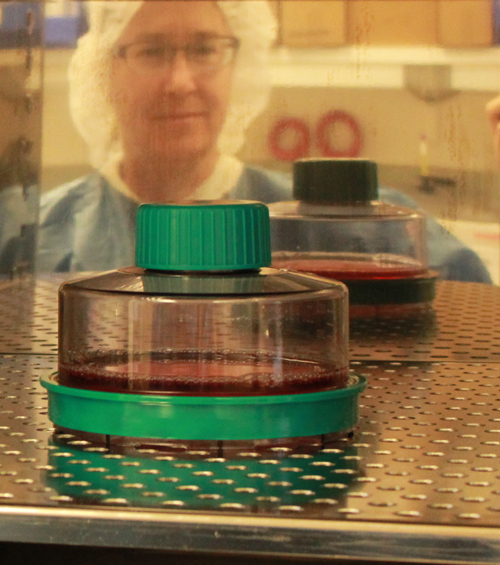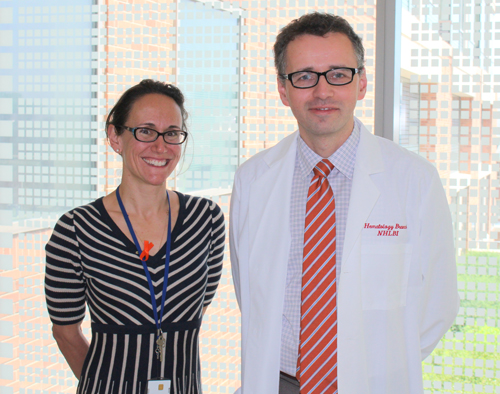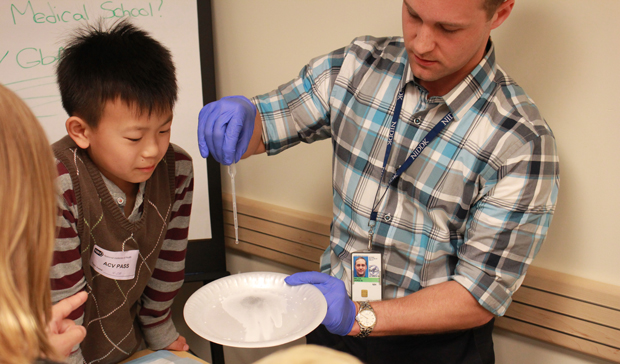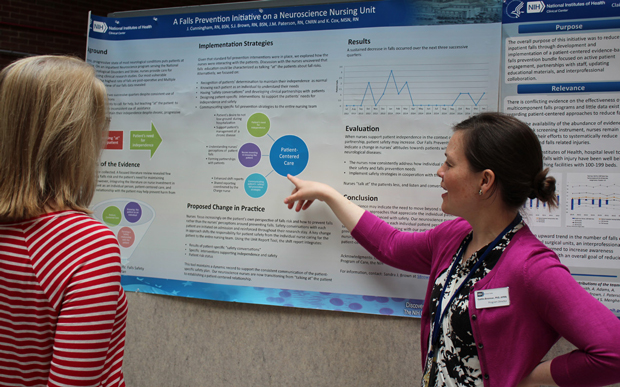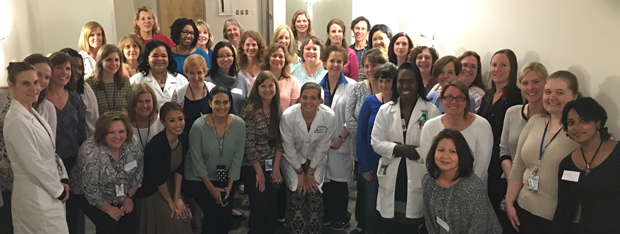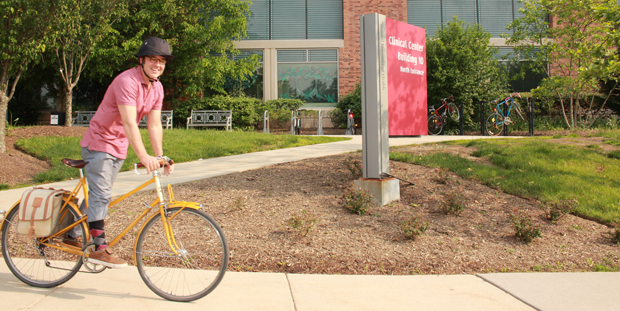June 2016
IN THIS ISSUE:
![]()
- Speak Up for Safety
- NIH director and UDP patient kick off Federal Workforce Day at Washington Nationals game
- NHLBI expert earns Presidential Award
- Groundbreaking new trial hopes to treat aggressive disease
- NIH Take Your Child to Work Day draws 3,600 students to campus
- Fourth MRSP class showcases yearlong research
- NIH launches Step it Up campaign across campus
- I am not my illness: patient artwork now on display
- National Nurses Week
- Hundreds of NIH cyclists enjoy 2016 Bike To Work Day
- Upcoming Events
Print this Issue ![]() (496 KB)
(496 KB)
ABOUT CC NEWS:
![]()
Published monthly by the Office of Communications and Media Relations. News, article ideas, calendar events, letters, and photographs are welcome. Submissions may be edited.
Clinical Center News
National Institutes of Health
Building 10, 10 Center Drive
Room 6-2551,
Bethesda, MD 20892-1504
Tel: 301-594-5789
Fax: 301-402-0244
Molly.Freimuth@nih.gov
2016 ISSUES:
![]()
QUICK LINKS:
![]()
Speak Up for Safety
 |
A toll-free anonymous telephone hotline is now open for staff, patients and visitors to report concerns. |
The NIH Clinical Center has created a new method for staff, patients and visitors to report safety concerns to the NIH Clinical Center leadership.
In addition to the existing electronic Occurrence Reporting System (ORS) that is available to all NIH staff, a toll-free ANONYMOUS telephone hotline is open for staff, patients and visitors to report concerns.
Information reported via the hotline will be forwarded anonymously to NIH Clinical Center Office of Patient Safety and Clinical Quality for triage, analysis, action and organizational improvement and learning.
The number of the new anonymous hotline is: 1-866-444-8811. If you have questions about this new reporting tool or about patient safety and clinical quality at the NIH CC, please contact Laura Lee, Director, Office of Patient Safety and Clinical Quality at llee@nih.gov.
View poster ![]() (67 KB)
(67 KB)
NIH director and UDP patient kick off Federal Workforce Day at Washington Nationals game
 |
Addison Carroll, a Clinical Center patient, plays with Screech, the Washington Nationals' mascot. |
On May 24, the Washington Nationals major league baseball team welcomed hardworking public servants to the ballpark as a part of Federal Workforce Day and Public Service Recognition Week. Dr. Francis Collins, director of the NIH, and a Clinical Center patient and her family were also special guests at the game. Collins, an avid musician, sang the national anthem before the game against the New York Mets.
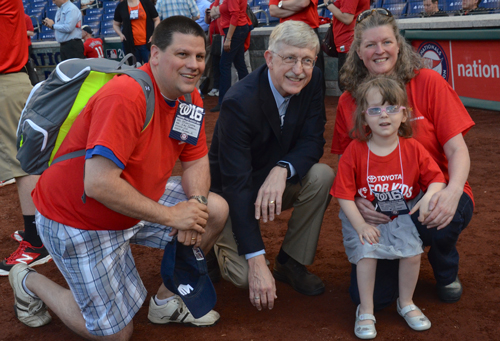 |
The Carrolls join Dr. Francis Collins, director of the NIH, on Nationals field. |
Addison Carroll, a patient, and her family were invited down to the field during Collins' performance.
Prior to hearing that they'd be able to attend the game, Addison's dad Ian and her mom Tammy were actively trying to find time in their clinical care schedule to attend Tuesday night's game.
Jokingly, they said to their care team in the NIH Undiagnosed Diseases Program (UDP), that "if [Dr. Collins] needs a little extra dose of courage, please let him know that Addison is in the stands and she can [come down and] hold his hand."
The Carrolls found out that Addison would be able to do just that while they were home in Vermont, packing for their trip to NIH. In the days leading up to the game, Addison watched videos of Dr. Collins singing and practiced putting her hand over her heart, so she was prepared for the national anthem.
"We couldn't be bigger NIH and UDP supporters. It just makes all the difference in the world to us," said Tammy. "[There's] hope in a situation where something has never been seen before."
NHLBI expert earns Presidential Award
 |
Dr. Andre Larochelle. |
In May, Dr. Andre Larochelle, an investigator at the National Heart, Lung, and Blood Institute received the Presidential Early Career Award for Scientists and Engineers (PECASE) presented by President Obama.
Larochelle was among 20 awardees, 17 of which are extramural investigators supported by NIH, working at institutions around the nation. The other three, including Larochelle, work in the NIH intramural program. Larochelle conducts research and sees patients at the NIH Clinical Center.
The award is the highest honor given by the federal government to outstanding scientists and engineers in the early stages of their independent research careers. NIH had funded 233 PECASE recipients.
"It means the world to me. I feel privileged and deep appreciation that our work in regenerative medicine was recognized by this award," Larochelle said. He was honored for his studies on regenerative therapies for inherited blood disorders. "It is comforting that, through this recognition of the work of scientists and engineers, our government acknowledges the importance of scientific innovation for our nation. Meeting our President in person, exchanging a few words, and experiencing his handshake and charismatic persona was an event I will cherish always."
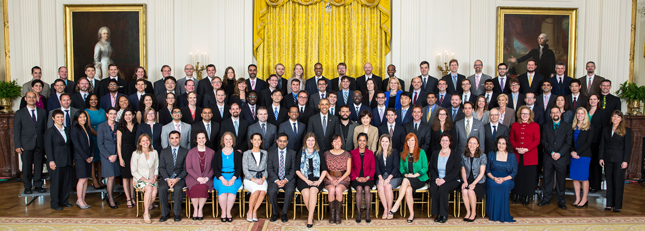 |
President Barack Obama joins recipients of the Presidential Early Career Award for Scientists and Engineers (PECASE) for a group photo in the East Room of the White House, May 5, 2016. (Official White House Photo by Lawrence Jackson) |
Groundbreaking new trial hopes to treat aggressive disease
| ||
|
If you're a healthy person, you likely have John Cunningham (JC) virus lying dormant in your body, harmless and causing no problems. But for those people whose immune system is compromised and suppressed, JC virus can cause a very rare, and often fatal, brain disease called Progressive Multifocal Leukoencephalopathy (PML). In April, experts at the NIH began a first-in-human trial to attempt to treat PML in patients with non-readily reversible immunosuppression, such as patients who have recently undergone organ transplant or stem cell transplant and individuals recently treated for cancer.
The study involves extracting certain blood cells from a healthy relative of a patient with PML, manipulating them in the Clinical Center Cell Processing Section lab to create JC virus-killing cells (called polyoma virus specific T cells) and then injecting them into the patient.
The Clinical Center, National Institute on Neurological Diseases and Stroke (NINDS) and National Heart, Lung, and Blood Institute (NHLBI) are collaboratively working on the study. PML has no cure and can lead to dementia, blindness and paralysis. While rare, PML could also affect people being treated for autoimmune conditions such as rheumatoid arthritis, multiple sclerosis and Crohn's disease.
With a mortality rate of about 80 percent for patients with an underlying immunosuppression that can't be reversed, this is a crucial piece of science to figure out.
"Using virus-specific T cells to treat severe infections has been life-saving for many patients undergoing bone marrow transplant. We are very curious if this method can improve outcomes in immunocompromised patients with PML," said Dr. Pawel Muranski, staff clinician in the Hematology Branch of NHLBI.
"This trial is a real step forward in being able to offer hope to people with otherwise few to no options for treatment," said Dr. Irene C.M. Cortese, Neuroimmunology clinic director in NINDS.
This protocol is supported by a Bench-to-Bedside NIH grant and is co-funded by NHLBI and the Office of AIDS Research.
NIH Take Your Child to Work Day draws 3,600 students to campus
NIH celebrated its 22nd year of Take Your Child to Work Day by providing 149 unique activities on and off campus, including volunteer opportunities. Around 3,600 students spanning the first to 12th grades registered to explore NIH labs and technology, learn about the day-to-day life of NIH staff and be inspired to consider careers in science and public service. Above, James Welch, a genetic counselor in the Metabolic Diseases Branch of National Institute of Diabetes and Digestive and Kidney Diseases, demonstrates what happens when chemical bonds are broken in a plastic foam plate. |
Fourth MRSP class showcases yearlong research
 |
Roop Dutta (far right), and 54 other Medical Research Scholars Program participants, gave their year-end scientific presentations in the Clinical Center. |
On May 9 and 10, NIH Medical Research Scholars Program (MRSP) participants gave their year-end scientific presentations and posters. The 55 dental, medical and veterinary scholars have completed a year-long research program in the NIH Clinical Center.
Presentation topics covered a wide variety of specialties including neurology, immunology, orthopedics, oncology and dermatology.
In the field of hematology, Roop Dutta, from Warren Alpert Medical School of Brown University, presented on the use of CRISPR/Cas9 technology to modify CXCR4 gene expression in human hematopoietic stem/progenitor cells.
"Leukocyte Adhesion Deficiency (LAD) is a genetic disorder where white blood cells do not work properly, and those who have LAD get chronic infections," Dutta explained. "My project used a new gene manipulation technology known as CRSIPR/Cas9 to correct LAD."
Following their presentations, Dr. Susan Leitman, director of the MRSP, thanked the students and wished them luck as they return to medical school in the fall.
"It's been a privilege to watch you grow and to be a part of your success," Leitman said. "You've made strong and, likely, life-long friendships and created a network of MRSP contacts who will continue to support and reach you throughout your career. Heartfelt congratulations to you all!"
"NIH is the place where we engage in war on disease," said Richard Wyatt, Deputy Director in the Office of Intramural Research, at the MRSP ceremony. "Maybe you haven't seen the victories yet, most research projects don't work the first time, but you are certainly better prepared for a fight. You'll be able to make a great difference in what you do next. Thanks for coming to the NIH."
Thirty-nine scholars, out of the class of 55, conducted their work in the Clinical Center. Five students in the MRSP program were mentored by Clinical Center leaders and embarked on the following research projects:
- Victor Carlson, from Sidney Kimmel Medical College at Thomas Jefferson University, was mentored by Dr. Frances Gavelli. Carlson conducted research on tibiofemoral configurations that predispose to anterior cruciate ligament injury;
- Comfort Elumogo, from Case Western Reserve University School of Medicine, was mentored by Dr. David Bluemke. Elumogo conducted research on the evaluation of the effects of myocardial infarction and scarring on CT, MRI and PET;
- Scott Galey, from the Cleveland Clinic Lerner College of Medicine of Case Western University, was mentored by Dr. Diane Damiano. Galey conducted research on lower limb biomechanics in children with cerebral palsy-induced crouch gait wearing an assistive gait device;
- Andrew Sohn, from Sidney Kimmel Medical College at Thomas Jefferson University, was mentored by Dr. Ron Summers. Sohn conducted research on the detection of calcific atherosclerosis in the internal iliac arteries with computer-aided diagnosis system;
- Lingsheng Li, from the University of Oklahoma College of Medicine, was mentored by Drs. Marion Danis and Ann Berger. Li conducted research on psychosocial and spiritual healing in an indigent patient population.
NIH launches Step it Up campaign across campus
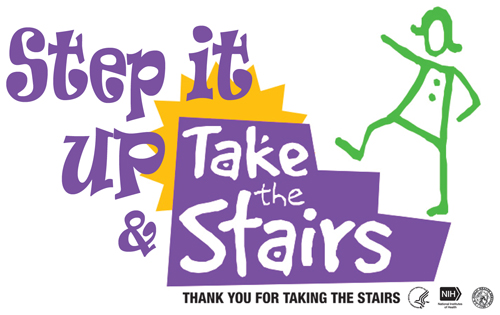 In June, NIH launched a health campaign on campus called 'Step It Up – Take the Stairs' to encourage the use of stairs in the workplace. The initiative was created by U.S. Surgeon General VADM Vivek Murthy in 2015. On the NIH campus, the U.S. Public Health Service Commissioned Corp Officers will continue the Generals call to action for staff to Step it Up and to promote walking and walkable communities.
In June, NIH launched a health campaign on campus called 'Step It Up – Take the Stairs' to encourage the use of stairs in the workplace. The initiative was created by U.S. Surgeon General VADM Vivek Murthy in 2015. On the NIH campus, the U.S. Public Health Service Commissioned Corp Officers will continue the Generals call to action for staff to Step it Up and to promote walking and walkable communities.
The campaign was launched at the 9th annual NIH Take a Hike Day where more than 650 people signed up to walk and /or run 3.2 miles around the perimeter of the NIH campus (see photo below).
Most NIH employees spend a significant part of their day at worksites, which are key areas for people to integrate physical activity into their daily lives. A CDC study [disclaimer] found that displaying motivational signs at worksite elevators and stairwells led to a significant increase in the use of stairs.
There are many benefits to incorporating physical activity into a daily routine:
- People who are physically active tend to live longer and have lower risk for heart disease, stroke, type-2 diabetes, depression and some cancers.
- Physical activity can also help with weight control and may improve academic achievement in students.
- Taking the stairs also reduces costs and energy used to power the elevators.
"A team of 21 Commissioned Corps Officers from 12 Institutes and Centers at NIH volunteered to plan and implement the campaign to promote taking the stairs instead of the elevators," said CAPT Dr. Peter Kilmarx, deputy director of the NIH Fogarty International Center, who initiated the program.
If you are new to using the stairs, it is recommended to start slowly. A great way to get started is by taking one floor at a time or combining the use of stairs and elevators for multiple flights. Another way to incorporate stairs into your day is to take them anytime going up one to two flights and down up to three flights.
Join NIH in taking action and Step It Up – Take the Stairs! View NIH fitness and wellbeing information.
 |
The Step It Up campaign was launched at the 9th annual NIH Take a Hike Day where more than 650 people signed up to walk and /or run 3.2 miles around the perimeter of the NIH campus. |
I am not my illness: patient artwork now on display
When patients arrive at the Clinical Center, they are often facing one of the biggest medical challenges of their lives, but, during downtime, Hannah Wilson, an art therapist, presents a creative and artistic challenge that pushes their illnesses aside.
Wilson has been working with 20 patients on the art project titled "I am not my Illness." In May, the artwork was placed on display on the first floor outside of Rehabilitation Medicine and the 1NW Inpatient Unit.
The "I am not my illness" project allows pediatric and adult patients the opportunity to "honor their experience." Patients are given materials and asked to make a project based on the statement, "I am not my illness, I am_______." Patients reflect on who they are and share their unique interests, passions, strengths, abilities, family relationships, goals and dreams.
"In the Clinical Center, patients often benefit from art therapy sessions' being a non-threatening opportunity to express, explore, honor and validate both the difficult and painful emotions that can arise when facing a major medical or mental health condition, as well as their strengths, sense of hope, wellness and resiliency," Wilson said. "I think that everyone here has a powerful story to tell, and art therapy can give them a way to tell their story that may be easier than talking. It is not just artmaking; it is therapy."
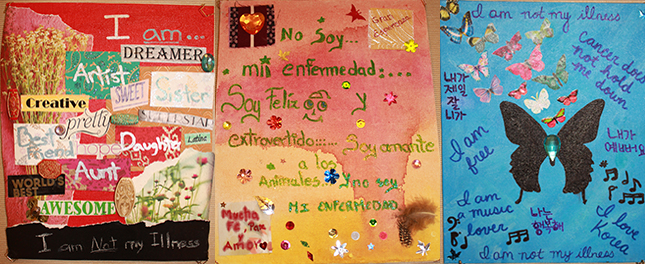 |
Each piece of artwork is a response to the statement "I am not my illness" by adult Clinical Center patients receiving art therapy. The translation for the piece which includes Spanish test is as follows: I am not my illness. I am happy and outgoing. I am an animal lover and I am not my illness. |
National Nurses Week
|
Hundreds of NIH cyclists enjoy 2016 Bike To Work Day
Bike to Work Day 2016 was celebrated at NIH and across the nation May 20. This year, more than 500 Clinical Center employees participated in the event. Above, Dr. John Tisdale, an investigator with the National Heart, Lung, and Blood Institute and the National Institute of Diabetes and Digestive and Kidney Disease, participated in Bike to Work Day. Tisdale, who conducts research and sees patients in the Clinical Center, rode about 6 miles from his home to Building 10. Find a bike rack and locker near your workplace on campus. |
Upcoming Events
Most lectures will be streamed live and archived
Clinical Center Grand Rounds Lecture
Sub-Saharan Africa and the Genetic Basis of Congenital Heart Disease
June 29, 2016, 12 noon – 1:00 p.m.
Lipsett Amphitheater
Presented by Paul Kruszka, MD, NHGRI.
SAVE THE DATE: Clinical Center Grand Rounds Lecture
Contemporary Issues in Graduate Medical Education
July 6, 13, 20, 27, 2016
These yearly lectures bring interesting speakers and topics geared toward clinical fellows.
Clinical Center Grand Rounds Lecture
Contemporary Issues in Graduate Medical Education
Outcomes-Based Education as a Pathway to Expertise: Where We Are and Where We Need to Go?
July 6, 2016, 2016, 12 noon – 1:00 p.m.
Lipsett Amphitheater
Presented by Eric Holmboe, MD, Accreditation Council for Graduate Medical Education (ACGME).
Clinical Center Grand Rounds Lecture
Contemporary Issues in Graduate Medical Education
Factors in Communicating with Diverse Patients
July 13, 2016, 12 noon – 1:00 p.m.
Lipsett Amphitheater
Presented by Eliseo Perez-Stable, MD, NIMHD.
Clinical Center Grand Rounds Lecture
Contemporary Issues in Graduate Medical Education
Professional Self-Regulation, Board Certification, and the Physician Scientist
July 20, 2016, 12 noon – 1:00 p.m.
Lipsett Amphitheater
Presented by Lois Margaret Nora, MD, American Board of Medical Specialties (ABMS).
Clinical Center Grand Rounds Lecture
Contemporary Issues in Graduate Medical Education
Ethics and Ebola: Recommendations of the Presidential Commission for the Study of Bioethical Issues
July 27, 2016, 12 noon – 1:00 p.m.
Lipsett Amphitheater
Presented by Kata Chillag, PhD, Presidential Commission for the Study of Bioethical Issues.
NOTE: PDF documents require the free Adobe Reader.

